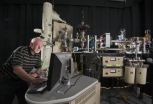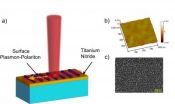(Press-News.org) Researchers at the Wyss Institute for Biologically Inspired Engineering at Harvard University have created a gut-on-a-chip microdevice lined by living human cells that mimics the structure, physiology, and mechanics of the human intestine—even supporting the growth of living microbes within its luminal space. As a more accurate alternative to conventional cell culture and animal models, the microdevice could help researchers gain new insights into intestinal disorders, such as Crohn's disease and ulcerative colitis, and also evaluate the safety and efficacy of potential treatments. The research findings appear online in the journal Lab on a Chip.
Building on the Wyss Institute's breakthrough "Organ-on-Chip" technology that uses microfabrication techniques to build living organ mimics, the gut-on-a-chip is a silicon polymer device about the size of a computer memory stick. Wyss Founding Director, Donald Ingber, M.D., Ph.D., led the research team, which included Postdoctoral Fellow, Hyun Jung Kim, Ph.D; Technology Development Fellow, Dan Huh, Ph.D.; and Senior Staff Scientist, Geraldine Hamilton, Ph.D. Ingber is also the Judah Folkman Professor of Vascular Biology at Harvard Medical School and the Vascular Biology Program at Children's Hospital Boston, and Professor of Bioengineering at Harvard's School of Engineering and Applied Sciences.
The new device mimics complex 3D features of the intestine in a miniaturized form. Inside a central chamber, a single layer of human intestinal epithelial cells grows on a flexible, porous membrane, recreating the intestinal barrier. The membrane attaches to side walls that stretch and recoil with the aid of an attached vacuum controller. This cyclic mechanical deformation mimics the wave-like peristaltic motions that move food along the digestive tract. The design also recapitulates the intestinal tissue-tissue interface, which allows fluids to flow above and below the intestinal cell layer, mimicking the luminal microenvironment on one side of the device and the flow of blood through capillary vessels on the other.
In addition, the researchers were able to grow and sustain common intestinal microbes on the surface of the cultured intestinal cells, thereby simulating some of the physiological features important to understanding many diseases. These combined capabilities suggest that gut-on-a-chip has the potential to become a valuable in vitro diagnostic tool to better understand the cause and progression of a variety of intestinal disorders and to help develop safe and effective new therapeutics, as well as probiotics. The gut-on-a-chip could also be used to test the metabolism and oral absorption of drugs and nutrients.
"Because the models most often available to us today do not recapitulate human disease, we can't fully understand the mechanisms behind many intestinal disorders, which means that the drugs and therapies we validate in animal models often fail to be effective when tested in humans," said Ingber. "Having better, more accurate in vitro disease models, such as the gut-on-a-chip, can therefore significantly accelerate our ability to develop effective new drugs that will help people who suffer from these disorders."
Gut-on-a-chip represents the most recent advance in the Wyss Institute's portfolio of engineered organ models. The platform technology was first reported on in Science in June 2010, where a living, breathing, human lung-on-a-chip was described. That same year, the Wyss received funding from the National Institutes of Health and the U.S. Food and Drug Administration to develop a heart-lung micromachine to test the safety and efficacy of inhaled drugs on the integrated heart and lung function. In September 2011, the Wyss was awarded a four-year grant from the Defense Advanced Research Projects Agency to develop a spleen-on-a-chip to treat sepsis, a commonly fatal bloodstream infection.
###About the Wyss Institute for Biologically Inspired Engineering at Harvard University
The Wyss Institute for Biologically Inspired Engineering at Harvard University (http://wyss.harvard.edu) uses Nature's design principles to develop bioinspired materials and devices that will transform medicine and create a more sustainable world. Working as an alliance among Harvard's Schools of Medicine, Engineering, and Arts & Sciences, and in partnership with Beth Israel Deaconess Medical Center, Brigham and Women's Hospital, Children's Hospital Boston, Dana Farber Cancer Institute, Massachusetts General Hospital, the University of Massachusetts Medical School, Spaulding Rehabilitation Hospital, and Boston University, the Institute crosses disciplinary and institutional barriers to engage in high-risk research that leads to transformative technological breakthroughs. By emulating Nature's principles for self-organizing and self-regulating, Wyss researchers are developing innovative new engineering solutions for healthcare, energy, architecture, robotics, and manufacturing. These technologies are translated into commercial products and therapies through collaborations with clinical investigators, corporate alliances, and new start-ups.
Harvard’s Wyss Institute creates living human gut-on-a-chip
By simulating the structure, microenvironment, and mechanical behavior of human intestine, a new microdevice could provide insights into disorders and help evaluate potential treatments
2012-03-27
ELSE PRESS RELEASES FROM THIS DATE:
Sandia National Laboratories' Ion Beam Laboratory looks at advanced materials for reactors
2012-03-27
ALBUQUERQUE, N.M — Sandia National Laboratories is using its Ion Beam Laboratory (IBL) to study how to rapidly evaluate the tougher advanced materials needed to build the next generation of nuclear reactors and extend the lives of current reactors.
Reactor operators need advanced cladding materials, which are the alloys that create the outer layer of nuclear fuel rods to keep them separate from the cooling fluid. Better alloys will be less likely to deteriorate from exposure to everything from coolant fluids to radiation damage.
Operating a reactor causes progressive ...
Boston University researchers develop microfluidic chip to stem flu outbreaks
2012-03-27
BOSTON -- The H1N1 flu pandemic in 2009 underscored weaknesses in methods widely used to diagnose the flu, from frequent false negatives to long wait times for results. Now Boston University researchers have developed a prototype of a rapid, low-cost, accurate, point-of-care device that promises to provide clinicians with an effective tool to quickly diagnose both seasonal and pandemic strains of influenza, and thus limit the spread of infection.
Boston University Biomedical Engineering Associate Professor Catherine Klapperich led the team of engineering and medical researchers ...
Researchers discover a new path for light through metal
2012-03-27
WASHINGTON -- Helping bridge the gap between photonics and electronics, researchers from Purdue University have coaxed a thin film of titanium nitride into transporting plasmons, tiny electron excitations coupled to light that can direct and manipulate optical signals on the nanoscale. Titanium nitride's addition to the short list of surface-plasmon-supporting materials, formerly comprised only of metals, could point the way to a new class of optoelectronic devices with unprecedented speed and efficiency.
"We have found that titanium nitride is a promising candidate ...
WTFast.com Destroys Lag and Gives First-Person Shooter Gamers a Competitive Advantage From Anywhere Around the World
2012-03-27
Using unique proprietary technology, WTFast accelerates the online connection between gamers and servers, dramatically increasing performance for the world's most popular franchises. WTFast users can see drastic improvements in performance boosting game connection speeds by as much as 70 per cent. This is vital for gamers who live remotely from the host game servers.
"Our service gives its users a huge advantage in multiplayer FPS games regardless of where you are in the world," said Rob Bartlett, CEO of WTFast. "In some cases we've seen ping rates drop ...
When we test, do we stress?
2012-03-27
Your mother had a doctor's appointment for a memory test. The results are conclusive: she presents with the first signs of Alzheimer type dementia. Now, to get to her appointment, your mother, who is no longer used to driving in town, took her car, looked for a parking space for 15 minutes, got lost in a labyrinth of one-way streets, had never used those new electronic parking meters before and is convinced that the "machine" stole her credit card number. Out of breath, she walked 20 minutes looking for the doctor's office and finally arrived late for her appointment, even ...
Nicaragua Sets New Record in FDI Attraction
2012-03-27
The Government of Nicaragua recently revealed that the country received US$967.9 million in foreign direct investment (FDI) during 2011, a new record for the country in FDI inflows and a 91 percent growth when compared to the US$507.9 million attracted in 2010.
The FDI attracted in 2011 was led mainly by the energy, telecommunications and free zones sectors, which together accounted for 52 percent of total FDI. The development of these sectors has contributed significantly in increasing the country's productive capacity and boosting its economy.
Specifically, in the ...
University of Maryland completes most extensive full face transplant to date
2012-03-27
Baltimore, MD -- The University of Maryland released details today of the most extensive full face transplant completed to date, including both jaws, teeth, and tongue. The 36-hour operation occurred on March 19-20, 2012 at the R Adams Cowley Shock Trauma Center at the University of Maryland Medical Center and involved a multi-disciplinary team of faculty physicians from the University of Maryland School of Medicine and a team of over 150 nurses and professional staff.
The face transplant, formally called a vascularized composite allograft (VCA), was part of a 72-hour ...
Finding reason in delusion
2012-03-27
Dementia -- an acute loss of cognitive ability -- can be marked by memory loss, decreased attention span, and disorientation. It occurs in severe disorders such as Alzheimer's disease. Despite the fact that the condition is common, especially among older persons, there is still a lack of effective treatment.
According to Prof. Jiska Cohen-Mansfield of Tel Aviv University's Herczeg Institute on Aging and Sackler Faculty of Medicine, dementia sufferers are often prescribed psychotropic drugs to mitigate symptoms such as delusions. But this tactic can cause more harm than ...
Corcentric Announces Larry Nemerofsky as Director of Client Integration
2012-03-27
Corcentric, a leading provider of centralized invoice processing solutions for the automotive aftermarket industry, today announced the appointment of Larry Nemerofsky to the role of Director of Client Integration. Larry brings with him more than 30 years of experience in collaborating with corporate and senior-level decision makers to conceptualize business models, formulate strategies, develop effective cross-functional relationships, and solve business problems.
Previously, Larry served as Director, Customer Advocate Team at Cardone Industries, where he was responsible ...
Study of employee substance use shows the need for supervisor training
2012-03-27
BUFFALO, N.Y. -- To curb employees' on-the-job substance use and intoxication, bosses need to do more than just be around their employees all day, according to a new study from the University at Buffalo Research Institute on Addictions (RIA).
"It's only when employees think their supervisor knows how to detect substance use -- and is willing to do something about it -- that employees' drinking and drug use on the job decreases," explains Michael Frone, PhD, senior research scientist at RIA and research associate professor of psychology.
"Contact with a supervisor, ...
LAST 30 PRESS RELEASES:
The Ceramic Society of Japan’s Oxoate Ceramics Research Association launches new international book project
Heart-brain connection: international study reveals the role of the vagus nerve in keeping the heart young
Researchers identify Rb1 as a predictive biomarker for a new therapeutic strategy in some breast cancers
Survey reveals ethical gaps slowing AI adoption in pediatric surgery
Stimulant ADHD medications work differently than thought
AI overestimates how smart people are, according to HSE economists
HSE researchers create genome-wide map of quadruplexes
Scientists boost cell "powerhouses" to burn more calories
Automatic label checking: The missing step in making reliable medical AI
Low daily alcohol intake linked to 50% heightened mouth cancer risk in India
American Meteorological Society announces Rick Spinrad as 2026 President-Elect
Biomass-based carbon capture spotlighted in newly released global climate webinar recording
Illuminating invisible nano pollutants: advanced bioimaging tracks the full journey of emerging nanoscale contaminants in living systems
How does age affect recovery from spinal cord injury?
Novel AI tool offers prognosis for patients with head and neck cancer
Fathers’ microplastic exposure tied to their children’s metabolic problems
Research validates laboratory model for studying high-grade serous ovarian cancer
SIR 2026 delivers transformative breakthroughs in minimally invasive medicine to improve patient care
Stem Cell Reports most downloaded papers of 2025 highlight the breadth and impact of stem cell research
Oxford-led study estimates NHS spends around 3% of its primary and secondary care budget on the health impacts of heat and cold in England
A researcher’s long quest leads to a smart composite breakthrough
Urban wild bees act as “microbial sensors” of city health.
New study finds where you live affects recovery after a hip fracture
Forecasting the impact of fully automated vehicle adoption on US road traffic injuries
Alcohol-related hospitalizations from 2016 to 2022
Semaglutide and hospitalizations in patients with obesity and established cardiovascular disease
Researchers ‘listen in’ to embryo-mother interactions during implantation using a culture system replicating the womb lining
How changing your diet could help save the world
How to make AI truly scalable and reliable for real-time traffic assignment?
Beyond fragmented markets: A new framework for efficient and stable ride-pooling
[Press-News.org] Harvard’s Wyss Institute creates living human gut-on-a-chipBy simulating the structure, microenvironment, and mechanical behavior of human intestine, a new microdevice could provide insights into disorders and help evaluate potential treatments


